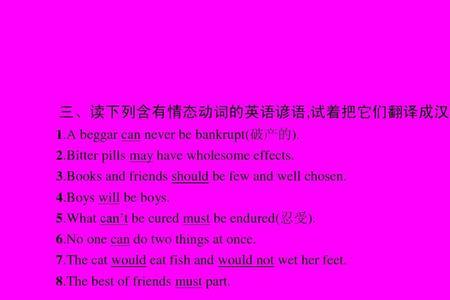no与not的几条区别
区别一:no是形容词,可直接放在名词之前。但若名词前已有the, a(n),any, much, enough等词,则用副词not。如:
正:I have no (=not any) money. 我没有钱。
正:I haven’t much money. 我没有很多钱。
误:I have no much (no any) money.
区别二:与形容词或副词的比较级连用时要注意:用not属于一般比较结构,意为“比不上”或“不如”用no则情况比较特殊,一般说来“no+形容词或副词比较级+than”所表示的意思是该形容词或副词的相反含义。如:
John is not better than Tom. 约翰不如汤姆好。
John is no better than Tom. 约翰和汤姆一样不好(=坏)。
类例:no richer than = as poor as 一样穷
no taller than = as short as 一样矮
no later than = as early as 一样早
区别三:在某些系表结构中,用not只表示一般的否定,用no则语气较强,可译为“决不是”。如:
He’s not a poet. 他不是诗人。
He’s no poet. 他决不是诗人。
区别四:no和not…any 均可表示完全否定。注意,英语习惯上不说any…not。如:
正:He hasn’t any money. 他没有钱。
正:No one came to see me. 没有人来看过我。
误:Any one didn’t come to see me.
区别五:非谓语动词的否定式,通常用not而不用no。如:
The teacher told him not to be late again. 老师叫他不要再迟到。
Not having received an answer, he decided to write another letter to her. 由于没接到回信,他决定再给她写一封信。
但在某些省略结构或固定结构中(尤其是用于命令,警告,标牌等场合),表示“禁止”“不许”等意义时,一般只用no。如:
No smoking. 禁止吸烟。
No admittance except on business. 非公莫入。
no和not的区别 接动词
区别:
1、Not(不)是副词,用于动词和助动词之后。
2、No(没有)是形容词,常位于名词前,用来否定这个名词。
No的用法
1.No(没有)是形容词,常位于名词前,用来否定这个名词。有时no否定名词时,可理解为这个名词的反义词,意思是“并非”。
2.No用于形容词、副词的比较级前,意思是“并不,毫不”。 We went no farther than the bridge.我们走到桥边就不再往前走了。
3.用于加强语气。 I don’t believe it.No,not I.我不相信这事,不,我才不相信哩。
4.用于表示惊奇、怀疑或不信。 He left yesterday.No.他昨天走了,不会吧!
5.用于委婉说法,“并非”。 in no small measure在不小的程度上
6.有时no =not at all,意思是“完全不是,决不是”。
7.在“No+动名词”的省略句中,表示“禁止,不准”的意思。这时,不能用“not any”代替“no”。 No smoking!禁止吸烟!? No spitting on the floor!不要随地吐痰!
Not的用法
1.Not(不)是副词,用于动词和助动词之后。
(1)That TV set is not here.那台电视机不在这里。
(2)I can not go out.我不能出去。
(3)I don’t think so.我不那样认为。






